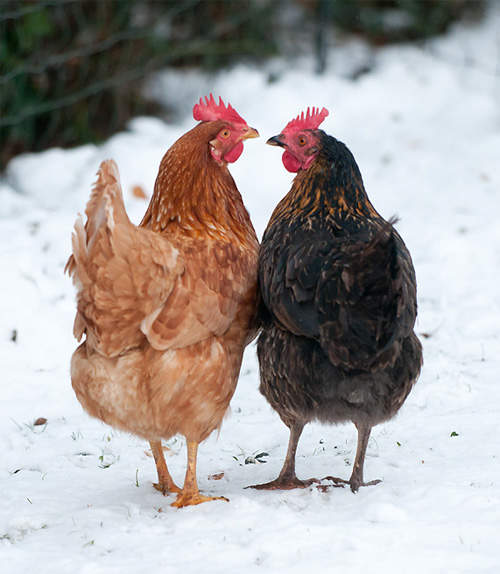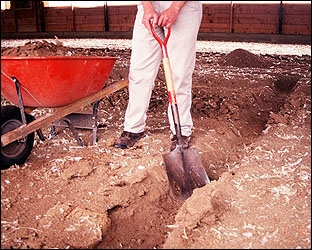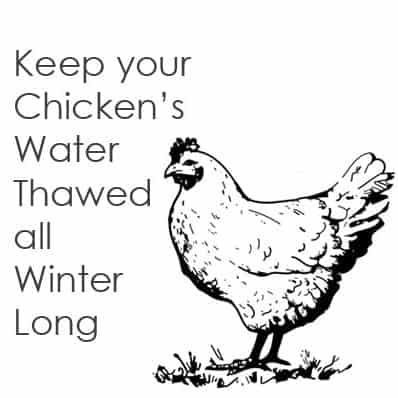
This will be our first winter with chickens and although it is kind of scary to think about.
There are really only two things that are pretty critical to keeping our ladies alive and well during the cold, Ohio winter that is up and coming and that is:
- making sure they have access to water (and not a frozen block of ice)
- and a dry coop.
We have been planning ahead to ensure that our six chicks survive and maybe even keep laying!
Water is a very important factor with chickens, as it is an essential nutrient and a requirement to regulate a chickens body temperature, help with digestion, growth and yes, even producing those eggs. Lack of water access, even for a few hours can result in a major egg production drop for weeks.
It is also important to note that chickens EAT MORE in the winter to help regulate their temperature and due to this they require more water to digest- if the water is frozen- your chickens will stop eating and will not be able to keep themselves warm.
3 frozen water Solutions:
- Use a cookie tin heater. For less than $10 and only 10 minutes of your time, a water heater can be made out of common, household stuff, which will keep water in plastic and even metal waterers liquid in those sub-zero, snowy temps. The thing is...electricity is REQUIRED.
- Use poultry nipple waterers. There are all kinds of nipple water systems that can be installed to ensure a water supply. You can even use a homemade system with a 5 gallon bucket, an aquarium heater to an already assembled unit with its own heating system, such as the Chicken Fountain. Electricity if Required for this method as well.
- You can HAUL it to your coop. If you don't have access to electricity, traditional waters can be used but will need to be changed frequently to prevent freezing. You should empty or remove at dusk and return fresh, unfrozen water first thing in the morning. I want to note that this is not the most efficient system, but with no other options, you will end up saving your brood.
Now let's talk about MOISTURE.
MOISTURE is the enemy, the boogie man, the *something in your closet. While, most chickens will tolerate cold weather well, the freezing temperatures inside the coop in addition to the added moisture will cause FROSTBITE. Chickens generate a great deal of moisture from breathing as well as from pooping, since droppings consist of 85 % water.
Frostbite usually occurs overnight in a cold, poorly ventilated coop.
Frostbite affects combs, wattles, and toes and can interfere with egg production.
Breeds with single combs are at the greatest risk for frostbite. Recommendations are to apply petroleum jelly to combs and wattles at night to prevent any moisture from clinging to them. It is unknown if this really prevents frostbite.
To control moisture in your coop, you can use a hygrometer with a relative target humidity of 50-70%.
You can also use Dropping Boards, which are a shelf designated to collect chicken poop deposited overnight. The boards are scraped down every morning, and dropping removed from the coop. The less droppings in the coop, the less moisture in the coop.
Droppings can also generate ammonia, which can be a respiratory hazard to the flock, particularly in a closed coop. Dropping boards eliminated a major source of the humidity and ammonia.
Not as if I need to say it, but DO NOT KEEP WATER INSIDE THE COOP. Controlling moisture from droppings is manageable with excellent ventilation, it is impossible to control moisture if the waterer spills in the bedding. There is no need for water in the coop.

Use SAND for bedding
Sand used as a litter inside the chicken coop is a great choice in the winter because it evaporates moisture faster than any other litter and it stays dryer as a result. Sand also retains warmth longer and will keep coop temperatures more stable. Try some Sweet PDZ sprinkled in the sand to help control moisture and ammonia.
Deep Litter is a method of chicken waste management that calls for droppings and bedding materials to compost inside the coop. This method required careful management, which includes stirring, monitoring and moisture content. The deep litter method, if implemented improperly, can cause serious health hazards to the flock.

To properly manage:
- Don't change the litter every few weeks.
- Don't begin the process mid-winter.
- Don't keep less than 4 inches of litter on the coop floor.
- Don't use diatomaceous earth (DE) in the litter.
- Don't relay on the chickens to do all the turning.
 Insulating is intended to retain radiant heat and reduce heat loss, making it more feasible to ventilate coop, but insulating a coop does NOT mean making it air-tight. If there are gaps that are not being used for ventilation, seal to prevent drafts.
Insulating is intended to retain radiant heat and reduce heat loss, making it more feasible to ventilate coop, but insulating a coop does NOT mean making it air-tight. If there are gaps that are not being used for ventilation, seal to prevent drafts. Insulation also must be hidden from your chickens, or..you guessed it...they will EAT it!
A great tips is to use feed bags for covering the insulation.
If you have heavy winds, it is important to insulate the roof and use a heavyweight plastic to cover the wind side.
And just a note- do not use straw or bales of hay inside the coop as insulation. Mold and fungus and even mites grow inside hay, which triggers that respiratory issue within the coop. Far better to have a cold coop than sick chickens.









No comments:
Post a Comment